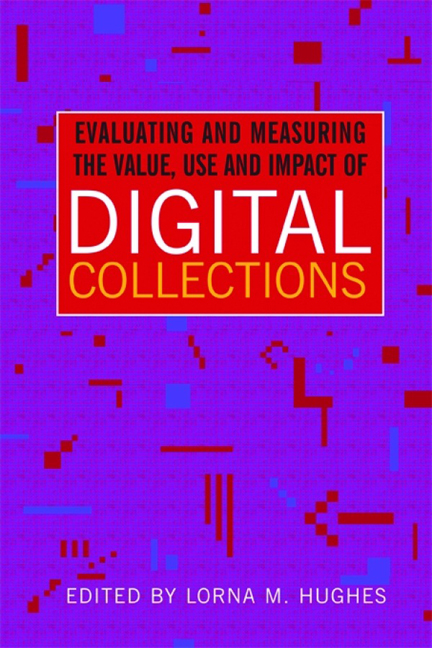Book contents
- Frontmatter
- Contents
- Figures and tables
- Foreword
- Acknowledgements
- The contributors
- 1 Introduction: the value, use and impact of digital collections
- Part 1 Digital transformations in libraries, museums and archives
- Part 2 Understanding and measuring the use, impact and value of digital collections
- Part 3 Enhancing the future impact and value of digital collections
- References and further reading
- Index
- Miscellaneous Endmatter
- Miscellaneous Endmatter
Foreword
Published online by Cambridge University Press: 08 June 2018
- Frontmatter
- Contents
- Figures and tables
- Foreword
- Acknowledgements
- The contributors
- 1 Introduction: the value, use and impact of digital collections
- Part 1 Digital transformations in libraries, museums and archives
- Part 2 Understanding and measuring the use, impact and value of digital collections
- Part 3 Enhancing the future impact and value of digital collections
- References and further reading
- Index
- Miscellaneous Endmatter
- Miscellaneous Endmatter
Summary
This set of chapters on digital collections fills an important gap in the professional literature of the memory institutions: libraries, museums, and archives. While much has been written of late on the evolution of digital scholarship, most analyses are written by and for scholars. These chapters are written by librarians, archivists and scholars engaged in building, assembling and digitizing content for a range of audiences, largely in the humanities. As noted in the acknowledgements, the book emerged from an expert seminar in e-research. The result is a coherent arrangement of chapters from a group of authors collaborating toward a common goal of identifying metrics for digital collections.
They survey developments, concerns, best practices and criteria for evaluation in a wide range of projects across the United Kingdom, Australia and New Zealand – where these authors currently are based – with reference to projects in the United States and elsewhere. The comparison of efforts in libraries, museums and archives, which in turn serve universities, schools, theatres and other environments, offers a rich set of case studies. A number of policy issues cut across these environments, most notably intellectual property rights and provenance.
Information professionals, managers and students alike will find much of value in this volume. The current environment of accountability is particularly problematic for the humanities. The ‘impact’ or value of collections may not be evident for years, decades, or even centuries after the origin of the materials, yet funders demand immediate economic indicators. These chapters take a balanced approach, acknowledging the trade-off in short and long term assessment of value, and to whom.
In all fields, the availability of scholarly content in digital form makes possible new research questions, methods and uses. The humanities especially have benefited from the ability to digitize historic documents, to mine large corpuses of texts, audio and images, and to assemble widely dispersed cultural objects into common repositories for comparison and analysis. Yet digitization is a means for scholarship and learning, not an end in itself. Careful assessments are required of trade-offs between usability and honesty to original form, between image quality, speed of access and cost, and between assorted other project-specific factors.
- Type
- Chapter
- Information
- Publisher: FacetPrint publication year: 2011

